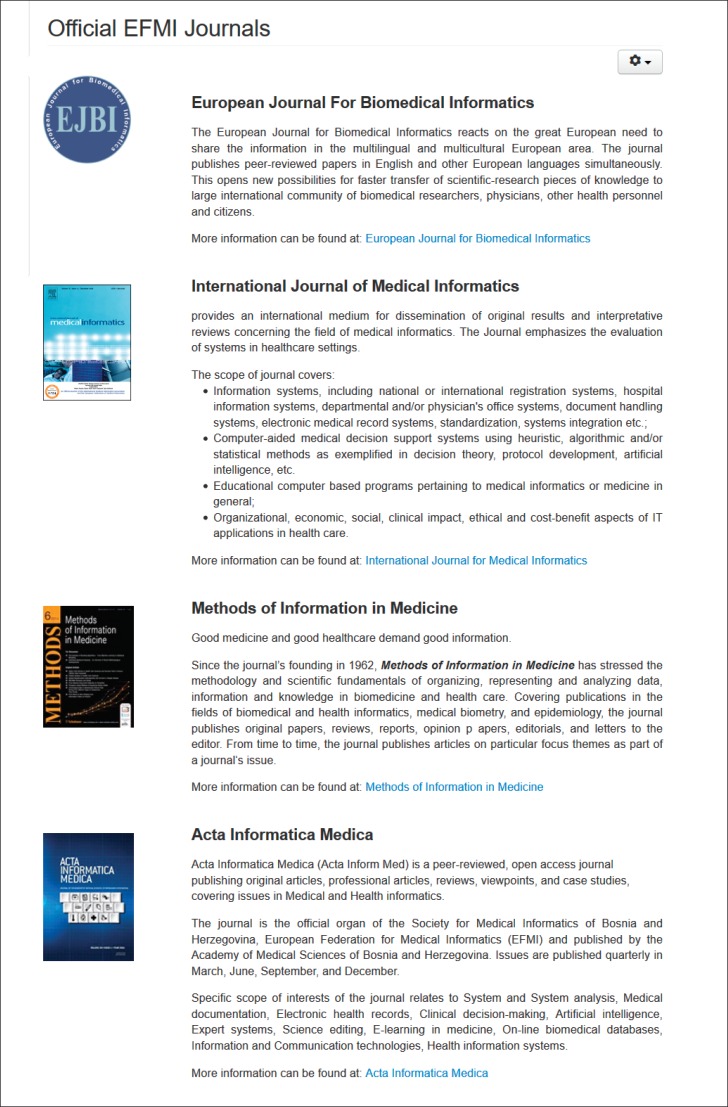There is no journal in the Balkans that covers the area of medical informatics (1). By searching scimagojr.com, the term “medical informatics” is not in options, and by clicking on the term “health informatics” there are no journals in the Balkans, the Mediterranean countries or Eastern Europe. Acta Informatica Medica is the last journal in this geographic area covering the field of Medical informatics.
During Medical Informatics of Europe (MIE 2018) Conference held in Gothenburg, Sweden, from 24 to 26th April of the 2018 at EFMI Council meeting, the journal Acta Informatica Medica became official journal of the European Federation for Medical Informatics, which represents a reward for hard work since the establishment of the journal in the Sarajevo (Bosnia and Herzegovina) - established by Izet Masic and Zoran Ridjanovic.
Acta Informatica Medica (open access journal publishing original articles, professional articles, reviews, viewpoints, and case studies, covering issues in Medical/Health/Biomedical informatics; journal is the official organ of the Society for Medical Informatics of Bosnia and Herzegovina and European Federation for Medical Informatics) has become the first journal from the territory of Bosnia and Herzegovina, which is recognized as the official journal of a European association. This does not apply only to medicine, but also to science in a broader sense.
Acta Informatica Medica is a peer-reviewed international quarterly journal published by Academy of Medical Sciences of Bosnia and Herzegovina. The International Editorial Board, together with the Bosnian and Herzegovinian forces, continues to raise the rating of the journal. The term medical informatics, after years of dubiousness with the term of health informatics, simply came to the edge of contact with the term Biomedical Informatics, so simply journal must open to new trends.
By spreading the scope of medical informatics, or more precisely biomedical informatics, the scope of journal is wider, all because (bio)medical informatics is part of every field of medicine. In collaboration of the international Editorial Board, 77 reviewers, technical team, under Editor supervision, Acta Informatica Medica published 59 papers in four issues in 2017 (62.7% of the original). Acceptance rate has decrease trend during the years, reaching 28.7% in 2017 (Figures 2-5).
Figure 2. Number of Acta Informatica Medical issues during the years.

Figure 5. Distribution of articles according to type in Acta Informatica Medica during the years.

The Google Scholar h5 index for Acta Informatics Medica for the period 2012-2016 is 17 and the h5 median 24. Scimagojr.com H index (for 2016) for Acta Informatica Medica is 10, while scimagojr.com index (SJR) is 0.251, showing a trend of growth year after year.
The journal is abstracted and indexed by Pubmed, PubMed Central, Europe PubMed Central, Scopus, EMBASE, EBSCO, Index Copernicus, Ulrich’s Periodicals Directory, Geneva Foundation for Medical Education and Research–GFMER, CAB abstracts, Global Health, HINARI, Pro-Quest, NewJour, ISC Master Journals List, Genamics JournalSeek, WorldCat, NLM Catalog, VINITI of RAS, CrossRef, Google Scholar, Catalyst, DynaPresse, ScopeMed, Kubon and Sagner OPAC.
Journal follows all rules, propositions and recommendations of ICJME, COPE, WAME, and also recommendations of Sarajevo Declaration on integrity and visibility scholarly journals (3)
Figure 1. Acta Informatica Medica as an official journal of the European Federation for Medical Informatics (2).
Figure 3. Acceptance rate of Acta Informatica Medica during the years.

The Editorial Board holds the ethical standards of publishing at its maximum, and tries to encourage young authors (as well as authors from Underdeveloped countries) to publish, reducing the already low publishing fee costs (if compared with other journals).
The long-term goal is to cancel the publication fee and leave an open access model of the journal. The Student Editorial Board is set up as an imperative in year 2018 (the journal wants to be available to PhD students for publishing their theses, or as a place where they can propose a new idea or some new project, and obtain a proctor for realization through the magazine). The promotion of the Acta Informatica Medica during the EFMI congress aims to establish the journal as a good and journal with high quality, and will aim to impose the author to publish his paper in field covered by the journal. The inclusion of the Acta Informatica Medica in the Web of Science family is set as an imperative and represents main and long-term goal of the Editorial Board.
Figure 4. Number of articles in Acta Informatica Medica during the years.

REFERENCES
- 1.Masic I, Begic E, Zunic L. Review of the Journal Acta Informatica Medica During Eight Year Period - 2008-2015. Acta Inform Med. 2015 Apr;24(2):84–89. doi: 10.5455/aim.2015.24.84-89. [DOI] [PMC free article] [PubMed] [Google Scholar]
- 2. [May 10th, 2018]. https://www.efmi.org/publications/efmi-journals.
- 3.Masic I, Begic E, Donev MD, Gajovic S, Gasparyan YA, Jakovljevic M, Milosevic BD, Sinanovic O, Sokolovic S, Uzunovic S, Zerem E. Sarajevo Declaration on Integrity and Visibility of Scholarly Journals. Croat Med J. 2016;57:527–529. doi: 10.3325/cmj.2016.57.527. [DOI] [PMC free article] [PubMed] [Google Scholar]



